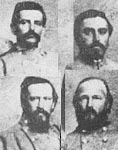Just past the land of the tall grass and big sky, just on the other side of the Big Rock Mountains away from the frontiers of civilization hides Hades County.
Hades County was founded and named in 1843 by Colonel James Middleton Saddlerock of the New Amsterdam 12th Volunteer Dragoons. Col. Saddlerock named the county after his mother-in-law, Innis Hades Jewell.
Col. Saddlerock brought with his dragoons three survey teams to help explore and map the territory encompassing Hades and its surrounding counties. They found a surprising variety of terrain with the county.
Hades County is 30 miles from east to west and 50 miles from north to south. Filling most of the western half of the county is the Titan mountain range named after its largest mountain, Mount Titan (8,157 feet above sea level.) Among the northern reaches of the Titans sits Silver Lake, a freshwater lake serving as a center for wildlife activity.
The northern quarter of the county is filled by the Thessaly Prairie, a 900-square-mile field of tallgrass prairie extending down from Thessaly County.
The foothills of the Titan Mountains are covered in pine forests mixed with deciduous as the land flattens out away from the mountains. The remainder of the county in the central and southern portions supports an irregular mix of grass steppes, wild prairie, woodlands and scrub land.
Out of the southern "toe" of the Titan range flows Division River which turns south in Bontess County from where the river continues all the way to the Gulf of California.
The southwestern corner of Hades County represents the northern part of the land of the Nilsud indian tribe. On their land sits the sacred Triple Rock, three massive columns of rock, 50 feet thick and 300 feet high.
In 1844, one of Saddlerock's survey teams, led by Captain William "Gunner" Janaidar, discovered silver in the northern part of the Titan range. It wasn't long before the news reached the towns on the eastern side of the Big Rocks. Soon, miners flooded the county searching for silver and opportunity. Other folks followed the miners into Hades County, folks who came to build towns, some who came to settle the land, and some who came to take advantage of everybody.
Seven main mining camps were eventually set up (not counting the countless small mines.) They are, from north to south, the Janaidar, the Bonafide, Sheol, Lucifer's Hole, Titan, Hades and the Silver Fire mine. The Nilsuds knew of silver in the territory having picked up a few nuggets from small streams and amongst the rocks of the Titans. The Nilsuds even spoke of a spot within the mountains containing a rock of silver so vast, it could be used to make another moon. The Nilsuds called this place Shamballah. Shamballah sounded good to the miners, until the Nilsud shamans also spoke of the curse that protects Shamballah.
The miners shook off this curse and began in ernest to find Shamballah. It is said three miners found Shamballah. Inside three weeks, the three miners were dead. One miner had brought his family to Hades County, and they had not lived past the next winter. Even the mule of one of the miners was found dead the day after its master's death.
Word of the deaths of the discoverers of Shamballah spread quickly around the county and, as is the way of frontier folk, each retelling of the story made the miners' deaths more gruesome, or increased the number of miners and family members who had died. Far-off family, friends, acquaintances and even entire hometowns of these miners were said to have been killed off by the Curse of Shamballah. Stories about the curse were enough to sppok many miners into other counties or professions; most simply went west where gold had been recently discovered.
Many of the homesteaders and farmers stayed behind, but the population of the county had dramatically decreased from the flush times.
In 1860, the War out East came, and men left their homes and the mines of the west to fight for their country. With the war raging, most forgot about the Shamballah curse; it had receded into simple folklore. When the war ended, men returned west; with them came the miners and opportunists.
The year is 1866, and the people of Hades County again look to opportunity, the future, the flush times and the hopes that one of them will be the lucky one to find the Shamballah lode.







